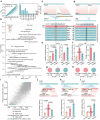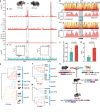Evolutionary origin of genomic structural variations in domestic yaks
- PMID: 37726270
- PMCID: PMC10509194
- DOI: 10.1038/s41467-023-41220-x
Evolutionary origin of genomic structural variations in domestic yaks
Abstract
Yak has been subject to natural selection, human domestication and interspecific introgression during its evolution. However, genetic variants favored by each of these processes have not been distinguished previously. We constructed a graph-genome for 47 genomes of 7 cross-fertile bovine species. This allowed detection of 57,432 high-resolution structural variants (SVs) within and across the species, which were genotyped in 386 individuals. We distinguished the evolutionary origins of diverse SVs in domestic yaks by phylogenetic analyses. We further identified 334 genes overlapping with SVs in domestic yaks that bore potential signals of selection from wild yaks, plus an additional 686 genes introgressed from cattle. Nearly 90% of the domestic yaks were introgressed by cattle. Introgression of an SV spanning the KIT gene triggered the breeding of white domestic yaks. We validated a significant association of the selected stratified SVs with gene expression, which contributes to phenotypic variations. Our results highlight that SVs of different origins contribute to the phenotypic diversity of domestic yaks.
© 2023. Springer Nature Limited.
Conflict of interest statement
The authors declare no competing interests.
Figures




References
-
- Qiu Q, et al. The yak genome and adaptation to life at high altitude. Nat. Genet. 2012;44:946–949. - PubMed
-
- Wu DD, et al. Pervasive introgression facilitated domestication and adaptation in the Bos species complex. Nat. Ecol. Evol. 2018;2:1139–1145. - PubMed
-
- Zhang K, Lenstra JA, Zhang S, Liu W, Liu J. Evolution and domestication of the Bovini species. Anim. Genet. 2020;51:637–657. - PubMed
-
- Lan D, et al. Population genome of the newly discovered Jinchuan yak to understand its adaptive evolution in extreme environments and generation mechanism of the multirib trait. Integr. Zool. 2021;16:685–695. - PubMed
Publication types
MeSH terms
LinkOut - more resources
Full Text Sources

